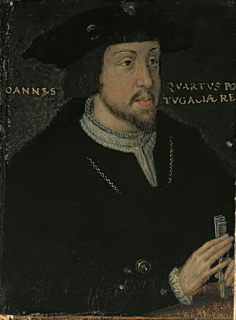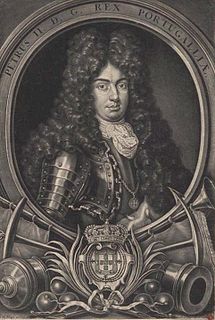
Afonso I, also called Afonso Henriques, nicknamed the Conqueror by the Portuguese, and El-Bortukali and Ibn-Arrink or Ibn Arrinq by the Moors whom he fought, was the first king of Portugal. He achieved the independence of the County of Portugal, establishing a new kingdom and doubling its area with the Reconquista, an objective that he pursued until his death.

Afonso V, known by the sobriquet the African, was a King of Portugal. His sobriquet refers to his military conquests in Northern Africa.

John II, called the Perfect Prince, was King of Portugal from 1481 until his death in 1495, and also for a brief time in 1477. He is known for re-establishing the power of the Portuguese monarchy, reinvigorating the Portuguese economy, and renewing his country's exploration of Africa and Asia.

DomPedro II, nicknamed "the Pacific", was the King of Portugal from 1683 until his death, previously serving as regent for his brother Afonso VI from 1668 until his own accession. He was the fifth and last child of John IV and Luisa de Guzmán.

Beatrice was the only surviving legitimate child of King Ferdinand I of Portugal and his wife, Leonor Teles. She became Queen consort of Castile by marriage to King John I of Castile. Following her father's death without a legitimate male heir, she claimed the Portuguese throne, but lost her claim to her uncle, who became King John I of Portugal, founder of the House of Aviz.
The Battle of Alfarrobeira took place on 20 May 1449. It was a confrontation between the forces commanded by King Afonso V of Portugal and his uncle Afonso, Duke of Braganza, against the army of the rebellious Peter, Duke of Coimbra. The place was Vialonga, near Lisbon, at the margins of the creek of Alfarrobeira. The result was the clear defeat and death of the Duke of Coimbra and the establishment of the Braganzas as the most powerful House of Portugal.

Joanna la Beltraneja was a claimant to the throne of Castile, and Queen of Portugal as the wife of King Afonso V, her uncle.

The Most Serene House of Braganza, also known as the Brigantine Dynasty, is a dynasty of emperors, kings, princes, and dukes of Portuguese origin which reigned in Europe and the Americas.

Theresa was Countess of Portugal, and for a time claimant to be its independent Queen. She rebelled against vasalic ties with her half-sister Queen Urraca of León and Castile. She was recognised as Queen by Pope Paschal II in 1116, but was captured and forced to accept Portugal's vassalage to León in 1121, being allowed to keep her royal title. Her political alliance and amorous liaison with Galician nobleman Fernando Pérez de Traba led to her being ousted by her son, Afonso Henriques, who with the support of the Portuguese nobility and clergy, defeated her at the Battle of São Mamede in 1128.

Succession to the British throne is determined by descent, sex, legitimacy, and religion. Under common law, the Crown is inherited by a sovereign's children or by a childless sovereign's nearest collateral line. The Bill of Rights 1689 and the Act of Settlement 1701 restrict succession to the throne to the legitimate Protestant descendants of Sophia of Hanover who are in "communion with the Church of England". Spouses of Roman Catholics were disqualified from 1689 until the law was amended in 2015. Protestant descendants of those excluded for being Roman Catholics are eligible.

Infante D. Afonso of Braganza, Duke of Porto was a Portuguese Infante of the House of Braganza, the son of King Luis I of Portugal and his wife, Maria Pia of Savoy. From 1908 to the abolition of the Portuguese monarchy in 1910 he was the Prince Royal of Portugal as heir presumptive to his nephew, King Manuel II.

The United Kingdom of Portugal, Brazil and the Algarves was a pluricontinental monarchy formed by the elevation of the Portuguese colony named State of Brazil to the status of a kingdom and by the simultaneous union of that Kingdom of Brazil with the Kingdom of Portugal and the Kingdom of the Algarves, constituting a single state consisting of three kingdoms.
FernandoPérez de Traba, also Fernão Peres de Trava in Portuguese, was a nobleman and count of the Kingdom of León who for a time held power over all Galicia. He became the lover of Countess Teresa of Portugal, through whom he attained great influence in that domain, and was the de facto ruler of the County of Portugal between 1121 and 1128. The Poema de Almería, a Latin poem celebrating one of Alfonso VII's major victories of the Reconquista, records that "if one were to see him [Fernán], one would judge him already a king."

Dom Afonso was the Prince Imperial and heir apparent to the throne of the Empire of Brazil. Born in Rio de Janeiro, he was the eldest child of Emperor Dom Pedro II and Dona Teresa Cristina of the Two Sicilies, and thus a member of the Brazilian branch of the House of Braganza.

The Portuguese House of Burgundy or the Afonsine Dynasty was a Portuguese dynasty that ruled the Kingdom of Portugal from its founding until the 1383-85 Portuguese Interregnum.

The Curse of the Braganzas is a myth, referred to in several historical chronicles, concerning the House of Braganza, that ruled the Kingdom of Portugal (1640–1910), the United Kingdom of Portugal, Brazil and the Algarves (1815–1822) and the Empire of Brazil (1822–1889) and, therefore, all the Portuguese Overseas Empire.















